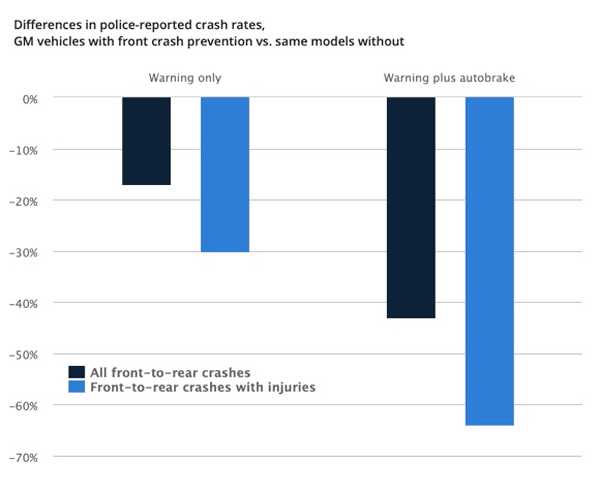Vehicle collision warning systems and especially automatic emergency braking are proven crash prevention technologies, reports a new study that was released this month by the Insurance Institute for Highway Safety (IIHS).
The study of General Motors vehicles that feature optional frontal-crash prevention systems indicates that “forward collision warning and automatic emergency braking prevent crashes.” IIHS also concluded that the autobrake feature with collision warning provided the most help in the more severe crashes that caused injuries.
- IC Bus Makes Electronic Stability Control & Collision Mitigation Standard on all Models
- Latest Safety Tech on Vehicles Will Help Avoid Hitting Pedestrians
- NBC Today Tests IC Bus Stability Control, Collision Mitigation Technology
- Congressional Bill Addresses School Bus Improvements Sought by NSTB
It should be stressed that the study did not include school buses. However, the findings are still relevant for setting expectations for when such features become widely adopted throughout most or almost all school districts nationwide.
The GM vehicles equipped with autobrake and forward collision warning systems encountered 43 percent fewer front or rear impact crashes of all severities. Those crashes are based on police reports accidents and typically resulted in at least $750 in damage.
The vehicles also experienced 64 percent fewer front and rear impact crashes with injuries than did the same vehicles that did not feature front crash prevention technology.
The study also found that for vehicles that are equipped with a forward collision warning capability only, had 17 percent fewer front and rear impact crashes, as well as 30-percent fewer injuries in such crashes.
The study author said that the results are similar to an earlier IIHS study that included Acura, Fiat Chrysler, Honda, Mercedes-Benz, Subaru and Volvo vehicles. That earlier study “found that the combination of forward collision warning and autobrake reduced front-to-rear crash rates by 50 percent for crashes of all severities and 56 percent for front-to-rear crashes with injuries. Forward collision warning without autobrake cut the rates 27 percent and 20 percent, respectively, for vehicles in that study.”
“The evidence has been mounting that front crash prevention works, and it works even better when it doesn’t solely rely on a response from the driver,” according to Jessica Cicchino, IIHS VP for research and author of both studies.
The new research included 2013-2015 Buick, Cadillac, Chevrolet and GMC brand vehicles. (GM provided VIN numbers “for vehicles with and without front crash and other crash avoidance systems.”)
Cicchino then received information from 23 states regarding police-reported crashes that involved just those VINs. Those police reports included details on the point of impact, which allowed Cicchino to focus on frontal and rear crashes—those are the crashes that front crash prevention systems are designed to help avoid or mitigate.
HLDI’s database was used to control for factors that might have affected crash rates, including the vehicle’s overnight location and driver characteristics.
Cicchino used the details that were provided by GM regarding the presence of other crash avoidance features, to control for advanced headlight features—which could affect the likelihood of rear-ending another vehicle in the dark.
The study pointed out that 20 automakers that represent over 99 percent of the U.S. auto market have agreed to make automatic emergency braking standard on practically every new passenger vehicle before September 2022.
Meanwhile, IC Bus at STN EXPO Reno in July announced it is making forward collision mitigation technology standard on all of its school bus models, in addition to electronic stability controls, and lane departure warnings as an option on its CE Series. Thomas Built Buses, which also announced at STN EXPO that it is making electronic stability controls standard, offers forward collision and lane departure warnings as an option on its Saf-T-Liner C2.
Blue Bird Corporation offers electronic stability control as an option, but has yet to respond to questions posed by School Transportation News on future availability of collision mitigation solutions.
A Lion Electric Company representative told STN that the Quebec-based manufacturer first seeks guidance from the Canadian federal government on adding electronic stability controls and collision mitigation technology in vehicles with Gross Vehicle Weight Ratings between 10,000 and 26,000 pounds, but added that final integration “won’t be difficult for us.”
The company official added that Lion Electric will need a test track to calibrate its vehicles once final guidance is provided.
Editor’s Note: The Insurance Institute for Highway Safety is an independent, nonprofit scientific and educational organization that is wholly supported by auto insurers. IIHS works to reduce deaths, injuries and property damage from crashes nationwide.















